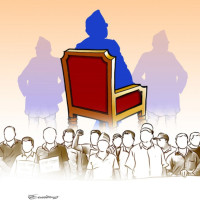Opinion
Human error traps
Reports on air crashes often blame the dead pilots to cover up official shortcomings
Sangam Prasain
During the 1980s and 1990s, Korean Air suffered a spate of crashes which earned it a bad reputation and even threatened its existence. Between 1970 and 1999, the airline had over 700 fatalities and lost a total of 16 aircraft in disasters. Interestingly, the airline turned itself around. Since 1999, it has had a perfect safety record.
Chapter seven of Malcolm Gladwell’s book Outlier opens with the story of Korean Air Flight 801 that crashed on August 6, 1997 during its approach into Antonio B Won Pat International Airport in the US. The plane was in good condition. The weather was bad, but not too bad. As the captain and the first officer decide to land the aircraft, they cannot see the runway. Alarms begin to go off as they get closer to the ground. The flight engineer suggests that the captain pull up and try again. After a few moments, he repeats the suggestion. This time, the captain agrees; but three seconds later the plane slams into the side of a mountain, killing almost everyone aboard.
The Korean story
Gladwell notes the flight crew’s behaviour. When the first officer comments on the weather, he is trying to tell the captain that the weather conditions are dangerous. When he says “how much he appreciates having weather radar” in the cockpit, he means to suggest that the flight commander “take a look at the radar”. In his analysis, Gladwell notices that the Korean language itself may have affected communication in the cockpit. The captain was tired, and did not hear what his first officer was trying to tell him. This communication failure caused the plane to crash.
Gladwell points out that the Korean language had a hierarchical problem which was one of the major factors behind the ‘error chain’. Besides, the language is excessively respectful to seniors, which is a good thing, but not necessarily when the aircraft is 30,000 feet up in the sky, which was another reason behind the error chain. In Korean culture, the listener is expected to pick up on subtle cues. Junior flight crew members don’t dare talk directly to the flight captain, even when he is doing things wrong. The inability of the pilots to communicate effectively, assert themselves and insist on their own needs resulted in the crash.
In 2000, Korean Air brought in experts to help them improve their communication in the cockpit. They began speaking English, a language that didn’t belong to their culture, and in a sense allowed them to have a different kind of identity when speaking it. The experts asked all the crew members to be more assertive when they were airborne, and use their first names only. And the directive to use first names only in flight reduced the fear of rank and hierarchy. It was not a miracle and the whole safety system was not analysed. The core problem was identified and rectified, which turned around Korean Air’s safety record.
Nepal’s case
In Nepal, there have been 55 fatal crashes and 84 incidents involving both airplanes and helicopters since 1946 when the first aircraft landed in the country, according to Aviation Safety Network. They resulted in 727 deaths. Of these mishaps, 95 percent are said to have occurred due to what is known in aviation terminology as CFIT (Controlled Flight into Terrain)—a state of flight when the pilots have full control of the flight and yet the plane hits terrain. A handful of crash investigation reports have been produced by the government investigation commission, and almost all of them have blamed ‘human error’. Why? It’s quick and easy and the most widely held view. Blame the dead pilots and cover up problems. Unfortunately, the core problem of frequent crashes has not been addressed. Every mistake, big or small, is always due to multiple contributing factors that all come together to form the ‘error chain’.
Gladwell says that crashes occur because of the accumulation of many small problems. Bad weather, tired pilots, new or unfamiliar airports, crew members who have only recently started to work together—it often takes all of these things to add up to disaster. “The typical accident involves seven consecutive human errors.”
Take the example of the probe report on Tara Air Flight 193 which crashed at Myagdi’s Solighopte in February killing all 23 aboard. The report says that the pilots deliberately entered cloud while operating under visual flight rules and deviated from the normal track due to the loss of situational awareness. A preliminary report on Fishtail Air’s helicopter crash that killed seven people also tells a similar story. Entering cloud under visual flight conditions is a violation of standard operating procedure. But why is it happening again and again? Anybody can ask a question, but nobody can give an answer. Can a close investigation into pilot behaviour help to prevent future plane crashes?
Nepal’s fluctuating weather is one of the major contributing factors behind air crashes. The government needs to install an en route weather monitoring system so that it can provide a safe operation plan. Airlines that have invested billions should also be able to hire weather analysts and set up a research department to do a comprehensive data analysis. The greatest blame for the failure to make Nepali skies safer seems to lie with the regulatory body. The lax regulation mechanism of the Civil Aviation Authority of Nepal (Caan) and its readiness to bow to operator pressure remain major problems. Until this is corrected, aviation experts say, the issue of air safety cannot be resolved. Another issue hampering improvement in the enforcement of safety requirements is the delay in splitting Caan into two entities—regulator and service provider. It has been 10 years since the process began but is nowhere near completion. The key is to focus on the system, not the person. Maybe, then, they will not set so many ‘human error traps’.
Prasain is an assistant senior sub-editor at The Kathmandu Post




 7.12°C Kathmandu
7.12°C Kathmandu










